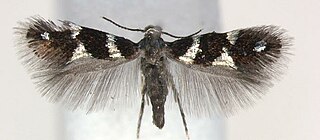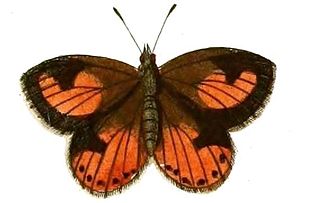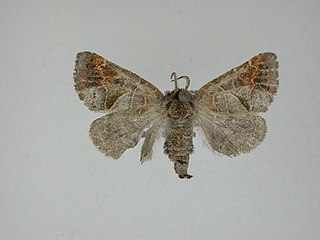
Urodidae, whose species are commonly known as false burnet moths, is a family of moths in the lepidopteran order. It is the type genus in the superfamily, Urodoidea, with three genera, one of which, Wockia, occurs in Europe.

The Heliozelidae, commonly known as shield-bearer moths, are a family of small, day flying monotrysian moths distributed worldwide. The larvae of most heliozelid species are leaf miners who cut distinctive shield-shaped cases from the surface of the host leaf, hence the common name. Some species are considered pests of commercial crops such as grapevines, cranberries, and walnuts. The taxonomy of this family is poorly understood.

Aloeides, commonly called coppers, is a genus of butterflies in the family Lycaenidae. Most can be found in South Africa, but a few species occur as far north as Kenya.
Chionosia is a genus of moths in the subfamily Arctiinae. The genus was erected by George Hampson in 1900.

Aroga is a genus of moths in the family Gelechiidae.

Isophrictis is a genus of moths in the family Gelechiidae.

Megacraspedus is a genus of moths in the family Gelechiidae, found primarily in the Palearctic.

Monochroa is a genus of moths in the family Gelechiidae.
Oxidercia is a genus of moths of the family Erebidae. The genus was erected by Jacob Hübner in 1825.
Pachyplastis is a monotypic moth genus of the family Erebidae. Its only species, Pachyplastis apicalis, is found in the Brazilian state of Amazonas. Both the genus and species were first described by Felder in 1874.

Plagiomimicus is a genus of moths of the family Noctuidae. The genus was erected by Augustus Radcliffe Grote in 1873.
Rhynchina is a genus of moths of the family Erebidae, that was formerly placed in the Noctuidae. The genus was erected by Achille Guenée in 1854.

Myelois is a genus of small moths belonging to the family Pyralidae. They are found in western Eurasia and adjacent regions such as the Maghreb.
Micropterix facetella is a species of moth belonging to the family Micropterigidae, which was described by Zeller in 1851. Micropterix facetella has a 4 male facetalla to 1 female facetalla ratio and during the mating season female facetella are said to visit a flower, only to eat, and the male facetella are there for the purpose to mate. For the common ratio, the male facetella goes to a near by location that another male facetella was already there as a pursuit of competition. A competition on who will get the female first, which is why there is 4 males facetalla for every 1 female facetella. It is known from Croatia and Slovenia.
Chionosia zonata is a moth of the subfamily Arctiinae first described by George Hampson in 1900. It is found in the South American country of Suriname.

Anomologinae is a subfamily of moths in the family Gelechiidae.

Clostera apicalis, the apical prominent or red-marked tentmaker, is a species of moth in the family Notodontidae. It was first described by Francis Walker in 1855 and it is found in North America.









